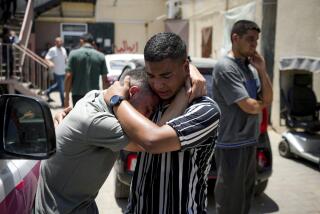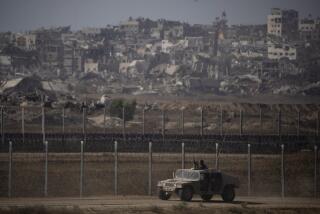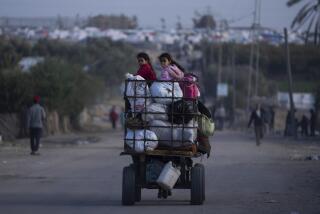Pounding of Sarajevo Most Brutal in Months : Balkans: Shelling of capital seems to underscore ineffectiveness of West’s latest Bosnia peace initiative.
SARAJEVO, Bosnia-Herzegovina — Sarajevo suffered its heaviest bombardment in months Sunday after government forces broke through Serbian artillery lines surrounding this devastated capital and the rebels retaliated by shelling entrapped civilians. Sarajevo Radio said 20 people were killed and more than 120 wounded.
The steady crash of shells into deserted, rubble-strewn streets and the constant whine of machine-gun and antiaircraft rounds seemed to punctuate, with each impact, the ineffectiveness of the latest Western peace initiative that was supposed to protect Sarajevo and five other embattled cities.
One of the other proposed safe areas, the eastern city of Gorazde, has been pounded for three days by an even more intense artillery assault, and the Serbian attackers were reported to have broken through the beleaguered enclave’s last line of defense.
Government-controlled Sarajevo Radio said the rebels overran Gorazde after inflicting heavy casualties in an assault that rained more than 1,000 shells on the town the previous day. Thousands were attempting to flee the city, the broadcast reported. It also said 11 soldiers had been killed and 34 wounded.
The radio report could not be verified for lack of U.N. or other Western observers in the besieged city. But if Serbs have indeed penetrated government defenses, the city of refuge for 70,000 that has defiantly withstood Serbian siege for more than a year could be on the verge of falling.
U.N. military observers have tried three times in the past several days to reach Gorazde to assess the situation and have each time been turned back by Serbian gunmen, said Cmdr. Barry Frewer, spokesman for the U.N. Protection Force in Bosnia.
“We must be witness to what is going on there. We must be allowed in there,” Frewer told journalists. But he conceded that any further pressure to gain access was dependent on an initiative from senior U.N. officers at the mission’s headquarters in Zagreb, Croatia.
The situation in Sarajevo, where nearly 400,000 residents and refugees are encircled by Serbian artillery, was equally desperate after one of the most intensive and sustained assaults this year.
Heavy shelling that had abated late Saturday resumed with stunning force at 4:30 a.m. Sunday, raining dozens of shells per minute for the next hour and a half.
Frewer said that during a 17-hour period that included the dawn battle, U.N. military observers in the capital counted 310 mortar and heavy artillery impacts--presumably of shells fired from Serbian positions--in the government-held city center and three blasts in Serb-held areas.
Fighting intensified again in the afternoon, rising to such a level that Sarajevo Radio described conditions in the capital as “extremely grave” and advised people to remain indoors or in shelters.
Sunday’s particularly fierce bombardment was punishment for government soldiers having broken a key Serbian supply line on Friday, said a government official who asked not to be named.
The Bosnian army, which is now predominantly Muslim, has seized a part of the road that arcs south of the capital and links the rebel political base at Pale to the main Serbian military barracks at Lukavica, the official said.
“They are angry that we have cut this road in three places, so they are retaliating against the center,” the source said of the Serbian shelling that began before sunrise and flared repeatedly throughout the day.
Government troops were thought to have held on to the vital section of supply line seized two days earlier and may have driven the Serbs higher into the hills that flank Sarajevo, as smoke from the persistent artillery blasts fired from and at Serbian positions was higher than in previous days.
While the reported government advance could signal a breakthrough in the 14-month-old siege, it took a heavy human toll and further undermined already meager chances for a negotiated solution to the bloody war.
Officials at Kosevo Hospital said six soldiers had been killed since the dawn offensive and nearly 100 wounded.
French Gen. Philippe Morillon, commander of the 9,000 U.N. troops in Bosnia, flew to Zagreb to confer with superiors about the latest violence, Frewer said.
The escalating clashes threatened to derail the latest Western initiative to stop the war in Bosnia, which has taken at least 150,000 lives and made 2 million homeless.
The United States, Russia, Britain, France and Spain have been pushing a new “action plan” for Bosnia, drafted in Washington a week ago Saturday, that would attempt to protect the embattled Muslims by erecting military cordons around Sarajevo and five other towns.
But Bosnian President Alija Izetbegovic has rejected the plan as “unacceptable” and accused the international community of rewarding Serbian aggression by refusing to take steps to roll back the rebels’ land grab.
Serbs now occupy 70% of Bosnia and have expelled Muslims and Croats from those areas. Croatian forces control much of the rest and also have recently engaged in the reviled practice known as “ethnic cleansing.”
Deputy Foreign Minister Sulejman Suljic warned in an interview that the Sarajevo government might soon ask the international community to bow out of negotiations and monitoring activities in Bosnia if it continues to avoid those steps needed to bring about a just solution.
Most Bosnians object to the safe areas proposal, to be debated by the U.N. Security Council this week, out of fear that the shell-shattered urban areas--Sarajevo, Tuzla, Bihac, Zepa, Gorazde and Srebrenica--would quickly deteriorate into shabby ghettos surrounded by hostile forces.
President Clinton has promised U.S. air cover to protect U.N. peacekeepers who might be dispatched to protect the enclaves, but the proposal outlined in Washington a week ago Saturday does not envision the use of Western force to protect the Bosnian civilians who would be confined to the safe areas.
More to Read
Sign up for Essential California
The most important California stories and recommendations in your inbox every morning.
You may occasionally receive promotional content from the Los Angeles Times.











